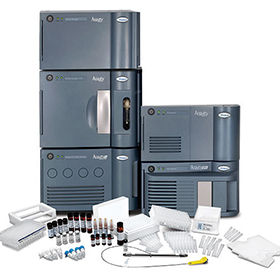Waters Transforms Glycan Analysis with New UPLC and UPLC-MS Analytical Workflows
Posted: 17 March 2015 |
New RapiFluor-MS Labeling Reagent & Sample Preparation Protocol Enhances Speed, Sensitivity, Simplicity of Released N-Glycan Profiling & Characterization…


New RapiFluor-MS Labeling Reagent and Sample Preparation Protocol Greatly Enhances Speed, Sensitivity, Simplicity of Released N-Glycan Profiling and Characterization
Waters Corporation (NYSE:WAT) has announced ground-breaking new technology for characterizing glycoproteins. The technology introduction at WCBP 2015 includes the new GlycoWorks™ RapiFluor-MS N-Glycan Kit, the Waters® ACQUITY UPLC®, the ACQUITY® UPLC FLR Detector and the ACQUITY QDa® detector, and enables scientists to analyze released N-glycans and achieve new levels of speed, sensitivity and simplicity while obtaining previously unattainable structural information.
This new set of technologies enables fast de-glycosylation and labeling and a workflow that reduces sample preparation time from a day to less than one hour, allows mass detection for characterization and development with sensitivity that is 100 to 1,000-fold better than current approaches, and enables routine laboratory use supported by a simple robust protocol without involving MS experts.
“Today’s introduction is a ground-breaking approach to glycan analyses. It means scientists can monitor and characterize released N-glycans like never before,” said Mike Yelle, Vice President, Consumable Business Unit, Waters Division. “The new workflows take what had been a specialized and complicated activity and transform it into one which scientists and laboratories can be successful with.”
Most biotherapeutic proteins are glycoproteins and the heterogeneous glycan populations on these proteins are critical quality attributes that affect potency, stability and therapeutic safety profiles. New drug submissions to regulatory agencies must contain detailed structural information pertaining to the attached glycans and proof the glycoprotein can be manufactured with a consistent glycan profile.
Supporting Glycoprotein Process Development, Monitoring and Batch Release
For scientists doing biotherapeutic process development, process monitoring or batch release, pairing the new RapiFluor-MS labeling technology with Waters ACQUITY UPLC H-Class System and QDa Detector ushers in a new era for released N-glycan profile monitoring. The speed and sensitivity advantages of the reagent and protocol enable simple, routine MS analysis. Confirming glycan assignment via mass data produced by the ACQUITY QDa Detector provides information previously unavailable. Scientists are now empowered to answer questions that frequently arise during glycan profile method development, transfer and execution without relying on mass spectrometry experts and higher-resolution LC-MS instruments.
This workflow allows biopharmaceutical organizations to more readily diagnose problems, accelerate decision-making and advance molecules to the clinic faster.
For analysts using fluorescence detection, the new kit, when used with the ACQUITY UPLC and the ACQUITY UPLC FLR Detector, reduces sample preparation time from a day to less than one hour while enhancing fluorescent sensitivity.
Supporting Glycan Characterization
Glycan characterization involves the identification of all of the glycans attached to a glycoprotein no matter how small their concentration and verification of their molecular structure. To do this efficiently requires UPLC-MS-MS instrumentation equal to the challenge.
The Waters Glycan Application Solution with UNIFI®, part of the broader Waters Biopharmaceutical Platform Solution with UNIFI introduced in 2013, consists of a high-resolution UPLC/QTof-MS system that characterizes and monitors glycans in biopharmaceutical discovery and development labs as well as in the highly-regulated late-stage development and QC organizations.
Now, with the enhanced sensitivity made possible by the RapiFluor-MS label, researchers will see a greater optical and mass spectrometric response. This facilitates accurate mass confirmation for low-level peaks and enhances MS/MS glycan fragmentation for definitive glycan assignment.
Also being launched are the RapiFluor-MS Dextran Calibration Ladder and Glycan Performance Test Standard, based on pooled IgG, to support benchmarking system performance and conduct Glucose Unit (GU)-based released glycan analysis studies. Waters became the first company to commercialize the GU-based methodology for dextran ladder-based retention time normalization, an approach pioneered by Professor Pauline Rudd of the National Institute for Bioprocessing Research and Training (NIBRT). The GU-based approach makes glycan analysis more robust, allowing UPLC-MS assays to transfer between instruments and laboratories more readily. A new GU glycan database, to facilitate GU and GU+ accurate mass glycan assignments, is in development in collaboration with Professor Rudd and her team at NIBRT and will be the subject of a joint poster presented at this year’s WCBP meeting.
For More Information
For more information about the GlycoWorks RapiFluor-MS N-Glycan Kit, visit www.waters.com/glycans.
About Waters Corporation (www.waters.com)
For more than 50 years, Waters Corporation has created business advantages for laboratory-dependent organizations by delivering practical and sustainable innovation to enable significant advancements in such areas as healthcare delivery, environmental management, food safety, and water quality, consumer products and high-value added chemicals worldwide.
Pioneering a connected portfolio of separations science, laboratory information management, mass spectrometry and thermal analysis, Waters technology breakthroughs and laboratory solutions provide an enduring platform for customer success.
With revenue of $1.99 billion in 2014, Waters is driving scientific discovery and operational excellence for customers worldwide.




